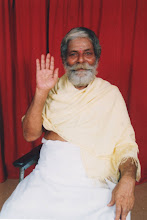Thursday, December 30, 2010
Mental calmness by breathing exercises
Thursday, December 23, 2010
How we should be with others?
Sunday, December 19, 2010
Single mindedness
Tuesday, February 2, 2010
Concentration practices mentioned in Yoga Sutras 34-39, Samadhi pada
Elongation of exhalation: Second, after establishing sound and steady awareness of the breath, allow the exhalation to gradually elongate, such that the amount of time spent exhaling is longer than the amount of time inhaling. The air will move outward more slowly with exhalation than with inhalation. Gradually allow the ratio to be two to one, where the exhalation is approximately twice as long as the inhalation. Pranayama is often translated as breath control. The rootayama actually means lengthening. Thus, pranayama more specifically meanslengthening the life force.
Not rechaka, puraka, and kumbhaka: There are other breathing practices that include rechaka (exhalation), puraka (inhalation) and kumbhaka (intentional holding of the breath). These practices are not the intent here in this sutra, particularly not the practice of breath retention. Though these may be useful practices at some stage of practice, they are not the subject of this sutra in relation to stabilizing the mind and making it tranquil.
The easiest way to practice this is to place your attention in the space between the breasts, the heart center. Simply imagine that there is a glowing luminosity there, about the size of the palm of your hand. Whether or not you literally see with your inner eye is not important; the practice works either way. Maintain an inner attitude that it does not matter what other thoughts, images, impressions or memories might arise in the mind field; you will hold that stance that these will not disturb or distract you. Stay only with that glowing inner luminosity in the heart.
Imagine your own mind free from desire: Another method is to imagine what your own mind would be like if it were temporarily free from any desires, wants, wishes, attractions, aversions, or expectations. It is like a game you are playing with yourself, wherein you see if you can pretend that your mind is in this tranquil state. With a little practice, this works amazingly well.
Virtually everybody already knows this principle of focusing on something enjoyable as a means of stabilizing the mind. However, the relative usefulness of the object chosen is a very different matter. Watching television, playing a game, listening to music, having a conversation, or many other activities may concentrate the mind enough to partially let go of the mental chatter from the activities of the day. While the principle of one-pointedness is in all of these, and may have some benefit, the meditator will learn to choose more refined objects to stabilize the mind for meditation. Remember, in this section and sutra we are talking about stabilizing and clearing the mind, not about deep meditation itself. This level of one-pointedness provides the stable foundation for the subtler meditation practices.
At the same time, however- as has been remarked in sutra 32, - we must limit ourselves to one way of seeking and keep to that ; otherwise we shall waste all our energies in mere spiritual "window shopping." We must never forget, though the Reality is everywhere, we can only make contact with it in our own hearts. As the great saint Kabir says in one of his most famous poems.
I laugh when I hear that the fish
in the water is thirsty.
You wander restlessly from forest
to forest while the Reality
is within your own dwelling.
The truth is here! Go where you will--
to Benaras or to Mathura;
until you have found God
in you own soul, the whole world
will seem meaningless to you.
